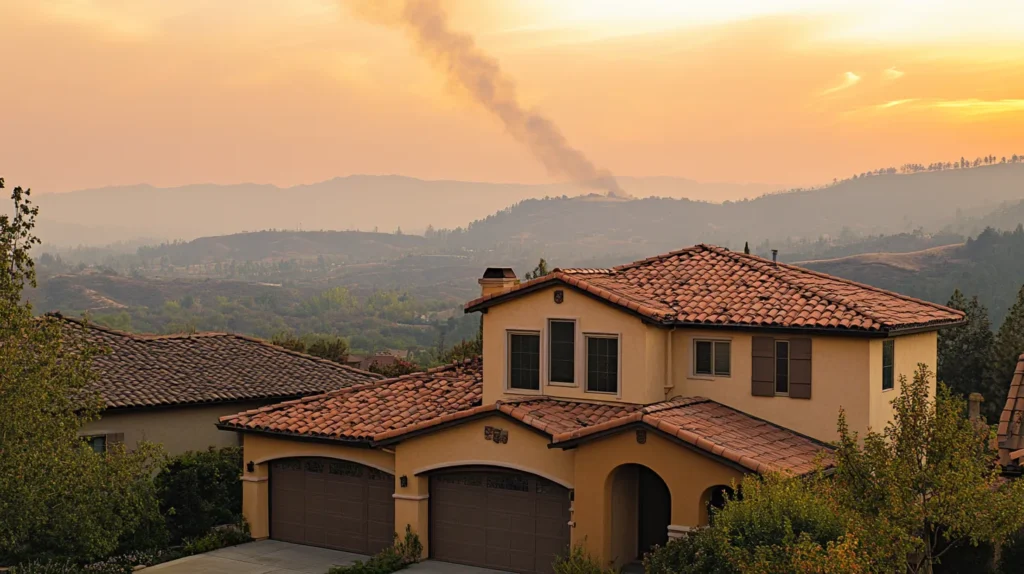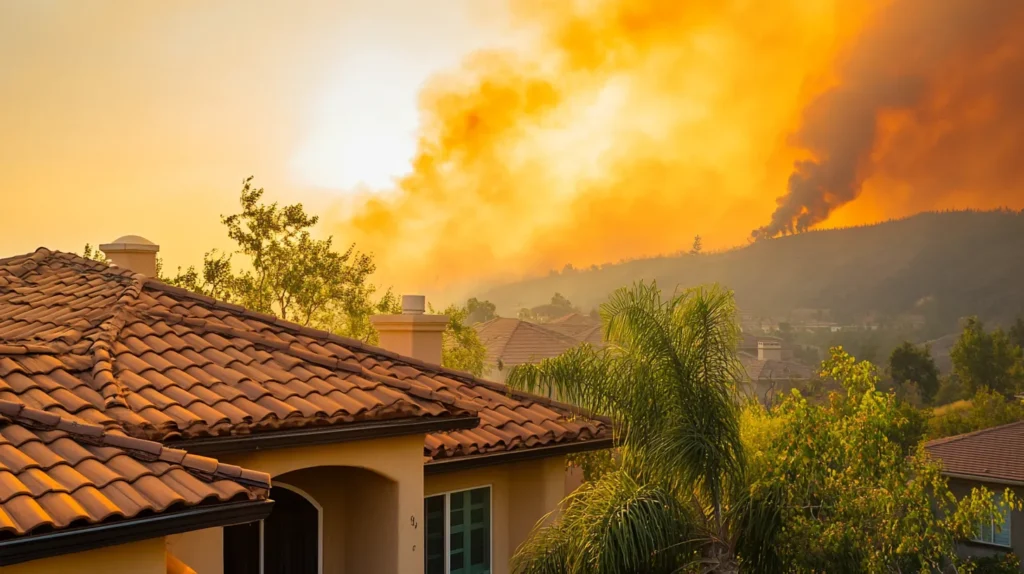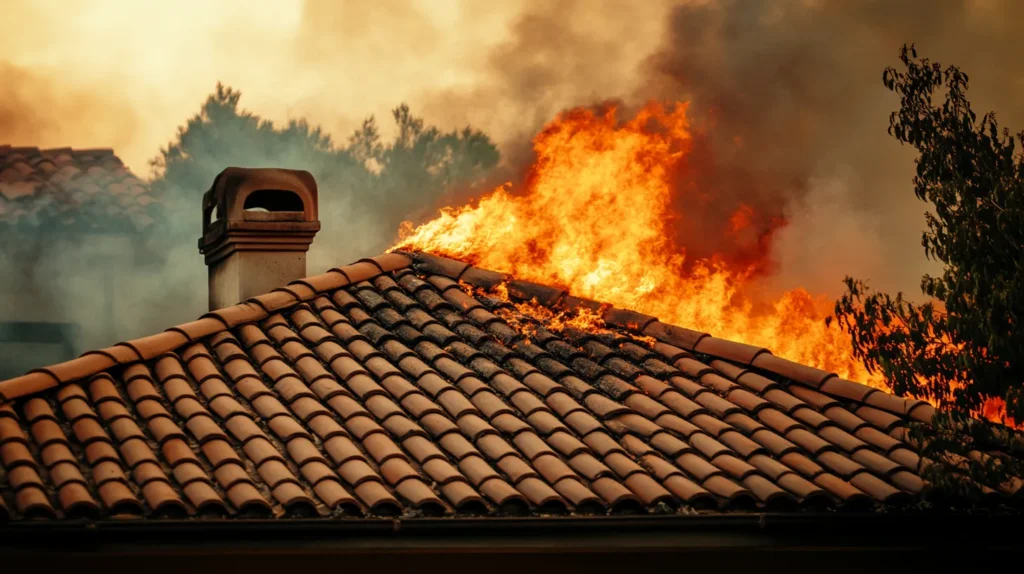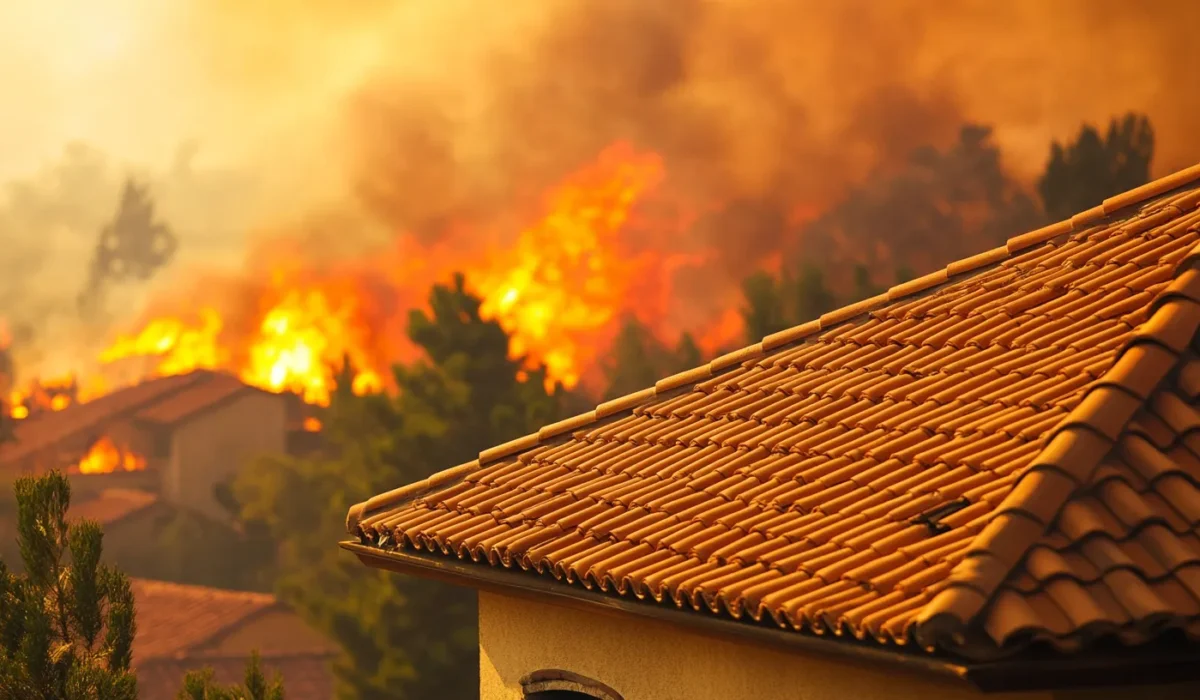Understanding the Fire Risk in California
California’s wildfire season is becoming longer and more intense due to severe weather conditions and prolonged droughts. Homeowners in wildfire-prone areas must take extra precautions to safeguard their properties against fire damage. One of the most effective ways to enhance wildfire protection is by installing fire-resistant roofing materials that can withstand intense heat, direct flames, and burning embers.
How Wildfires Damage Homes – The Role of the Roof
During fire season, wildfires spread rapidly due to wind-blown embers that can travel miles ahead of the actual fire. If these embers land on a roof made of flammable materials, such as wood shingles, they can easily ignite and cause catastrophic fire damage. Even a home that isn’t directly in the path of a wildfire can still be at significant risk if its roofing materials aren’t designed for fire resistance.
The Importance of Fire-Resistant Roofing
Investing in fire-resistant roofing is one of the best decisions homeowners can make in wildfire-prone areas. The right roofing material can help prevent embers from igniting your home and slow down the fire spread in case of an emergency. Class A fire-rated materials offer the highest level of fire resistance, making them ideal for homes in high-risk zones.

Top Fire-Resistant Roofing Materials for California Homes
Clay and Concrete Tiles
Clay and concrete tiles are among the best choices for fire-resistant roofing because they are non-combustible and provide excellent fire protection. These tiles have a Class A fire rating, meaning they offer the highest level of fire resistance. In addition to their safety benefits, tile roofing is durable, energy-efficient, and aesthetically pleasing.
One consideration when choosing clay and concrete tiles is their weight. They may require additional structural support, so it’s essential to consult a qualified roofing contractor before installation.
Metal Roofing
Metal roofs are another excellent option for fire resistance. They are lightweight, durable, and can withstand extreme weather conditions. Since metal is non-combustible, it won’t ignite from burning embers. Many metal roofing systems also come with fire-resistant underlayment for added protection.
Asphalt Shingles with Fire Retardants
While asphalt shingles are a common and affordable roofing material, they must be treated with fire retardants to achieve a Class A fire rating. Without these treatments, asphalt shingles can still pose a fire risk, especially if flames reach the roof’s underside.
Fiber Cement Roofing
Fiber cement is another Class A fire-rated option that provides excellent fire resistance. It is made from a mix of cement, sand, and cellulose fibers, making it highly durable and resistant to catching fire.
Contact Us
Additional Fire-Resistant Features for Maximum Protection
Fire-Resistant Underlayment
Even if you choose fire-resistant roofing materials, adding a fire-resistant underlayment provides extra security. This layer helps prevent fire spread if embers manage to penetrate the roofing material.
Ember-Resistant Vents
Wind-blown embers can enter a home through attic vents, igniting flammable items inside. Installing ember-resistant vents can help prevent embers from getting inside, reducing the chance of spot fires.
Proper Roof Design and Debris Removal
A well-designed roof minimizes areas where embers can collect. Homeowners should also prioritize debris removal, as dried pine needles, leaves, and branches can ignite quickly. Keeping the roof’s edge clean is a crucial step in wildfire defense.
California Building Codes and Fire Ratings
Homes in wildfire-prone areas must comply with local building codes that require fire-resistant roofing. The fire rating system includes:
- Class A fire-rated – The highest level of fire resistance, required in high-risk areas.
- Class B fire-rated – Moderate fire resistance, but not suitable for severe wildfire zones.
- Class C fire-rated – The lowest fire resistance, offering minimal protection.
A qualified roofing contractor can help ensure that your roofing materials meet local building codes for maximum fire protection.

Why Choose Tile Roofing for Your Home?
Tile roofing made from clay and concrete tiles offers unbeatable fire resistance and wildfire protection. Unlike other roofing materials, tile doesn’t melt or warp under high temperatures, and it effectively prevents catching fire from burning embers.
Key Benefits of Tile Roofing:
- Class A fire-rated for the highest level of fire resistance.
- Withstands extreme weather conditions, including intense heat and heavy winds.
- Highly durable and can last 50+ years with minimal roof repair.
- Energy-efficient, keeping homes cooler in summer.
How to Ensure Your Roof is Fire-Ready
If you’re unsure about your existing roof, schedule an inspection with a qualified roofing contractor. They can assess whether your home meets the latest fire protection standards and recommend upgrades if necessary.
Steps to Take:
- Assess Your Roof’s Fire Rating – Ensure it meets Class A fire-rated standards.
- Check for Gaps – Seal any openings where wind-blown embers could enter.
- Regular Roof Maintenance – Perform debris removal to clear dry leaves and pine needles.
- Upgrade to Fire-Resistant Roofing – Consider clay and concrete tiles for superior wildfire protection.
Final Thoughts: Protect Your Home with Fire-Resistant Roofing
With wildfire season in California becoming more intense, investing in fire-resistant roofing materials is a necessity, not a luxury. Choosing concrete tiles, metal roofing, or fiber cement can significantly reduce your home’s fire risk, providing enhanced protection for years to come.
If you’re ready to upgrade to a Class A fire-rated roof, contact Tile Roofing San Diego today. Our team of qualified roofing contractors specializes in fire-resistant roofing solutions tailored to the unique needs of homeowners in wildfire-prone areas.
Protect your home before the next wildfire season—schedule your consultation now!
Conclusion
Living in fire-prone areas means taking extra precautions to protect your home from wildfires. Choosing fire-resistant materials for your roof is one of the most effective ways to minimize the risk of fire damage. Materials like clay and concrete tiles, metal roofing, and fire-resistant underlayment provide strong protection against extreme temperatures and burning embers. Investing in high-quality roofing ensures long-term safety and durability. Upgrade your home with fire-resistant materials today to safeguard against future wildfires.

